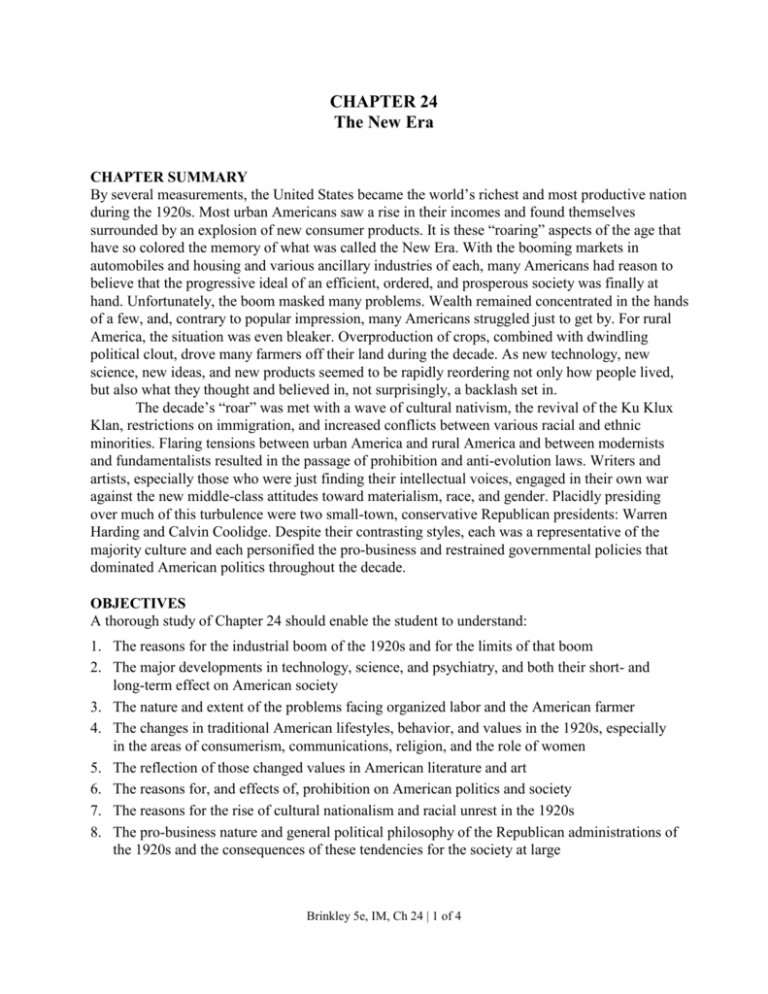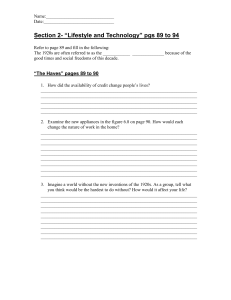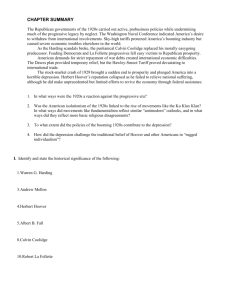CHAPTER 24
advertisement

CHAPTER 24 The New Era CHAPTER SUMMARY By several measurements, the United States became the world’s richest and most productive nation during the 1920s. Most urban Americans saw a rise in their incomes and found themselves surrounded by an explosion of new consumer products. It is these “roaring” aspects of the age that have so colored the memory of what was called the New Era. With the booming markets in automobiles and housing and various ancillary industries of each, many Americans had reason to believe that the progressive ideal of an efficient, ordered, and prosperous society was finally at hand. Unfortunately, the boom masked many problems. Wealth remained concentrated in the hands of a few, and, contrary to popular impression, many Americans struggled just to get by. For rural America, the situation was even bleaker. Overproduction of crops, combined with dwindling political clout, drove many farmers off their land during the decade. As new technology, new science, new ideas, and new products seemed to be rapidly reordering not only how people lived, but also what they thought and believed in, not surprisingly, a backlash set in. The decade’s “roar” was met with a wave of cultural nativism, the revival of the Ku Klux Klan, restrictions on immigration, and increased conflicts between various racial and ethnic minorities. Flaring tensions between urban America and rural America and between modernists and fundamentalists resulted in the passage of prohibition and anti-evolution laws. Writers and artists, especially those who were just finding their intellectual voices, engaged in their own war against the new middle-class attitudes toward materialism, race, and gender. Placidly presiding over much of this turbulence were two small-town, conservative Republican presidents: Warren Harding and Calvin Coolidge. Despite their contrasting styles, each was a representative of the majority culture and each personified the pro-business and restrained governmental policies that dominated American politics throughout the decade. OBJECTIVES A thorough study of Chapter 24 should enable the student to understand: 1. The reasons for the industrial boom of the 1920s and for the limits of that boom 2. The major developments in technology, science, and psychiatry, and both their short- and long-term effect on American society 3. The nature and extent of the problems facing organized labor and the American farmer 4. The changes in traditional American lifestyles, behavior, and values in the 1920s, especially in the areas of consumerism, communications, religion, and the role of women 5. The reflection of those changed values in American literature and art 6. The reasons for, and effects of, prohibition on American politics and society 7. The reasons for the rise of cultural nationalism and racial unrest in the 1920s 8. The pro-business nature and general political philosophy of the Republican administrations of the 1920s and the consequences of these tendencies for the society at large Brinkley 5e, IM, Ch 24 | 1 of 4 MAIN THEMES 1. How the automobile boom and the new technology fed the economic expansion of the 1920s 2. That many workers and farmers did not share equitably in the prosperity of the decade 3. How a nationwide consumer culture began to emerge and shape the larger society 4. How the ideas of the “new woman” emerged 5. The intellectual criticism of American society and the psychological effects on individuals of consumerism 6. The broad cultural conflicts between new ideas and ways of living with traditional beliefs and lifestyles 7. The policies, similar and not, of Warren Harding, Calvin Coolidge, and Herbert Hoover POINTS FOR DISCUSSION 1. Why did contemporaries refer to the 1920s as the New Era? Was this an appropriate label? 2. What were the main characteristics of this new national consumer-based society? Who gained from it? Who did not and why? 3. Analyze the intellectual and scientific forces that contributed to the emergence of a modern secular American culture in the 1920s? 4. Did progressivism die during the 1920s? Or was this the moment of its final triumph? Explain the reasoning behind your choice. 5. How and why did the role of women change during the 1920s? How and why did women reformers differ among themselves during the 1920s? 6. Briefly characterize how each of the following people seemed to typify certain aspects of the 1920s: Andrew Mellon, Herbert Hoover, Charles Lindbergh, Margaret Sanger, H. L. Mencken, Sinclair Lewis, Al Smith, and William Jennings Bryan. What was the unique vision of each person? Does one individual, or a combination of two or more, capture the spirit of the decade? 7. What was the vision of the Harlem Renaissance? 8. Why was the New Era a generally Republican era? How did the personalities and policies of Harding and Coolidge reflect the 1920s? 9. Why were the forces favoring prohibition, religious fundamentalism, and nativism so strong during the 1920s? 10. What does the election of 1928 tell us about the politics of the 1920s in general? MAP EXERCISE 1. Identify the major regional areas and cities that were the centers of urbanization in 1920. 2. Identify the states carried by Herbert Hoover and by Al Smith in 1928. INTERPRETATIVE QUESTIONS BASED ON MAPS AND TEXT 1. What technological and social forces were at work in the 1920s to break down regional differences? Brinkley 5e Instructor's Manual, Ch24 | Page 2 of 4 2. What conflicts between the modern secular, mainly urban, culture and the traditional culture manifested themselves in the 1920s? 3. What states did Hoover carry that would normally have been regarded as safely Democratic? Why did he make those inroads? 4. Why did Smith carry Rhode Island and Massachusetts despite losing other states where Democrats normally had a good chance for victory? Where did Smith make significant gains for the Democrats even though losing statewide totals? 5. To what extent did urban and rural culture become blended in the 1920s? How did they remain distinct? ESSAY QUESTION This question is based on the preceding map exercise. It is designed to test students’ knowledge of the geography of the area discussed in this chapter and of its historical development. Careful reading of the text will help students answer this question. 1. What does a state-by-state breakdown of the results of the election of 1928 tell you about the differences between the two major parties? Why did Hoover make inroads into the once solidly Democratic South? BIBLIOGRAPHY Beth L. Bailey, From Back Porch to Front Seat (1988) Stanley Coben, Rebellion Against Victorianism: The Impetus for Cultural Change in 1920s America (1991) Robert Crunden, From Self to Society: Transition in American Thought, 1919-1941 (1972) Lynn Dumenil, The Modern Temper: American Culture and Society in the 1920s (1995) James Flink, The Automobile Age (1988) Stephen Fox, The Mirror Makers: A History of American Advertising and Its Creators (1984) Louis Galambos and Joseph Pratt, The Rise of the Corporate Commonwealth: U.S. Business and Public Policy in the Twentieth Century (1988) Gary Gerstle, American Crucible (2000) Daniel Horowitz, The Morality of Spending: Attitudes Towards the Consumer Society in America, 1875-1940 (1985) Morton Keller, Regulating a New Economy: Public Policy and Economic Change in America, 1900-1933 (1990) Edward J. Larson, Summer for the Gods: The Scopes Trial and America’s Continuing Debate Over Science and Religion (1997) Elizabeth Lunbeck, The Psychiatric Persuasion: Knowledge, Gender, and Power in Modern America (1994) Nancy MacLean, Behind the Mask of Chivalry: The Making of the Second Ku Klux Klan (1994) George M. Marsden, Fundamentalism and American Culture (1980) Roderick Nash, The Nervous Generation: American Thought, 1917-1930 (1970) Michael Parrish, Anxious Decades: America in Prosperity and Depression, 1920-1941 (1992) Susan Smulyan, Selling Radio: The Commercialization of American Broadcasting, 1920-1934 (1994) Brinkley 5e, IM, Ch 24 | 3 of 4 For Internet resources, practice questions, references to additional books and films, and more, see this book’s Online Learning Center at www.mhhe.com/unfinishednation5. Brinkley 5e Instructor's Manual, Ch24 | Page 4 of 4







